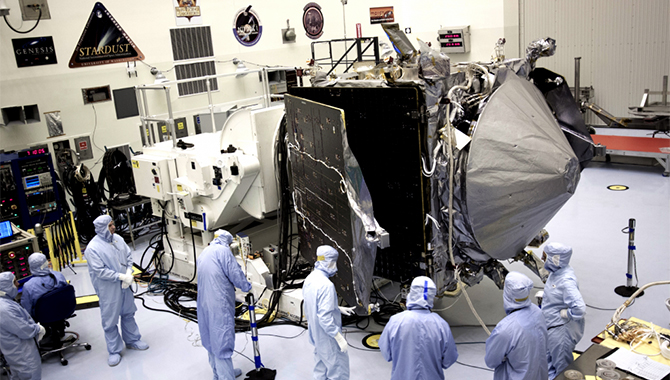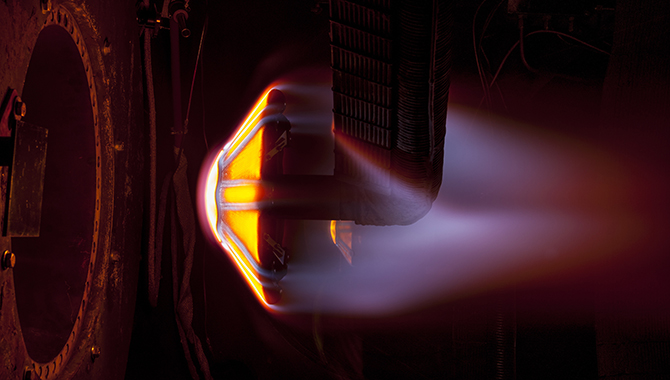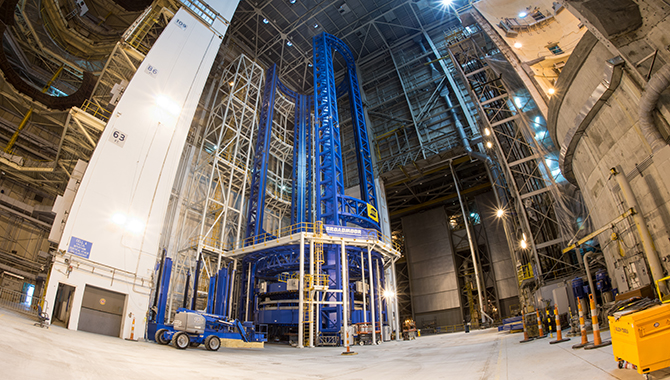
NASA Administrator Charles Bolden and others survey the Orion crew capsule, recently returned to Kennedy Space Center following its successful maiden flight.
Photo Credit: NASA/Cory Huston
Following the successful first flight of Orion, the Government Accountability Office (GAO) reported on issues impacting NASA’s human space exploration programs.
With the goal of safely transporting humans beyond low Earth orbit (LEO), NASA supports a trio of interconnected human space exploration programs: the Orion Multi-Purpose Crew Vehicle, the Space Launch System (SLS), and Ground Systems Development and Operations (GSDO).
Orion, the first spacecraft in 40 years designed to take humans beyond LEO, recently completed its maiden voyage: Exploration Flight Test-1 (EFT-1). Although the flight was unmanned, EFT-1 pitted the spacecraft against the rigors of space beyond LEO to test systems that are critical for crew safety. Orion’s virtually flawless performance suggests a new era of human space exploration is underway.
For EFT-1, Orion lifted off on a Delta IV Heavy rocket from United Launch Alliance (ULA). But Orion’s future lies with the SLS, NASA’s in-development heavy lift launch vehicle capable of sending the spacecraft into deep space. Together, the programs will form the foundation for NASA’s human space exploration endeavors in the decades ahead.
As part of its ongoing assessment of all NASA programs, the GAO recommended in July of 2014 that NASA present an adequate plan for developing the SLS that matched cost and schedule resources to program requirements. The agency has since done so, following NASA policy to develop an executable business case at the 70 percent joint confidence level (JCL), which indicates a 70 percent likelihood that the program will be completed in accordance with the stated budget and schedule. Based on the established JCL, the first test flight for the SLS has been pushed back from late 2017 to November of 2018.
The delay will benefit the Orion and GSDO programs as well. Despite the success of EFT-1, Orion still faces technical challenges, particularly regarding its parachute deployment system and heat shield. The team is currently waiting for critical data from the test flight in order to address these potential risks to crew safety. Lockheed Martin, which managed EFT-1 for the agency, expects to deliver data to the program during the first quarter of 2015. The data will then be analyzed during the Critical Design Review (CDR) planned for April. The GAO emphasized the critical nature of the EFT-1 data and the importance of factoring them into Orion design decisions going forward.
For all three programs, the GAO stated that funding remains an ongoing concern. According to a recent report from the National Research Council (NRC) Committee on Human Spaceflight, to be successful a manned deep space exploration program requires sustained political and financial commitments that persist across successive government administrations. The GAO cautioned that NASA must manage the potential for cost or schedule overrun for the SLS, Orion, and GSDO, as a problem with one program will likely impact all three. Going forward, the agency should also address GAO concerns about mission planning and lifecycle cost estimates, and define specific mission requirements for the SLS. A focus on long-term missions—beyond the proposed 2018 and 2021 flight tests—is essential to fully assess the programs’ needs and progress.
Finally, the GAO advised altering the SLS program’s internal timeline. The team continues to use 2017 as an informal goal for Exploration Mission-1 (EM-1), the initial Orion-plus-SLS flight test. While this accelerated timeframe may drive home the urgent nature of the initiative, it could overtax resources. Instead, the GAO encouraged the program to focus on the recently identified 2018 launch readiness date. The yearlong delay will support the success of all three programs as they move the agency farther along on its journey toward Mars.









